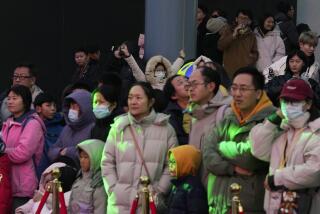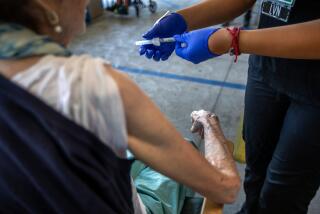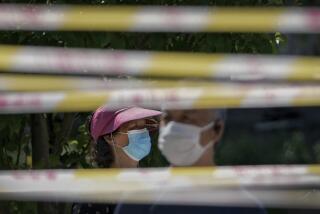China Sees Hepatitis B Advances
- Share via
BEIJING — The government claimed dramatic progress Tuesday in a five-year program to immunize children against hepatitis B, a disease that infects nearly 10% of China’s population and illustrates the daunting task of providing health services to the vast rural areas where the majority of the nation’s 1.3 billion people live.
About 11.1 million children in the poorest parts of the country have received vaccinations since 2002 in a project funded by the Chinese government and the Geneva-based GAVI Alliance, a partnership that counts among its sponsors the United Nations, the World Health Organization and the Bill & Melinda Gates Foundation.
The campaign focuses on 22 rural provinces, mostly in western China, where about 5.5 million babies are born each year, a third of China’s total.
Organizers estimated that the program had helped save about 200,000 lives in a country where thousands die each year of hepatitis-related ailments such as cirrhosis and liver cancer.
An estimated 120 million Chinese are infected with the disease, about one-third of the world’s cases. Almost 1 million new cases were reported in China last year.
Those who live with the disease frequently face discrimination.
Many Chinese employers and universities refuse to accept anyone who tests positive. Even some kindergartens refuse admission to children who are carriers of the virus.
The hepatitis problem is a reflection of the vast developmental gap between China’s rural and urban areas.
Public awareness of the disease, which is spread through the exchange of bodily fluids, is not as high as it is for HIV and AIDS.
In many rural areas, doctors have reused syringes and unknowingly spread the disease, particularly among children. The campaign aims to end the practice of reusing needles.
A vaccination within the first 24 hours after birth is considered the best way to prevent the disease from spreading from mother to child. But it wasn’t until 1992 that China included it as part of a routine immunization program.
Even then, the price was relatively high compared with other postnatal vaccinations, and families had to pay out of their own pockets. Many, especially in the poor countryside, decided to go without.
Only last year did the government pass a regulation making the vaccination free, the Health Ministry said.
The government has set a goal of reducing the overall hepatitis B infection rate to less than 7% over the next five years, and the rate of infection for children younger than 5 to less than 1%.
Julian Lob-Levyt, executive secretary of the GAVI Alliance, said the program was a model for other developing countries trying to stop the spread of diseases that can be prevented by vaccines.
But a study of the five-year, $76-million campaign shows that more than 1 million Chinese babies born each year in the area covered by the project are not receiving the vaccination.
Officials say that in many of China’s poverty-stricken rural areas, children are delivered at home in remote mountain villages or nomadic herders’ tents, far from hospitals and access to medical information.
“There is a huge bottleneck to ensure the delivery of the timely birth dosage to home births,” said Yang Weizhong, deputy director of China’s Center for Disease Control and Prevention.
Another problem is the growing size of China’s migrant labor force or “floating population.”
Farmers who become urban laborers move frequently around the country and often don’t seek medical attention. The immunization rate among them remains low, Yang said.
More to Read
Sign up for Essential California
The most important California stories and recommendations in your inbox every morning.
You may occasionally receive promotional content from the Los Angeles Times.













